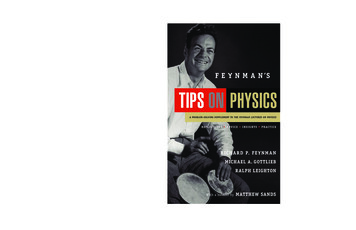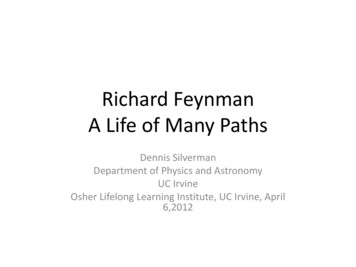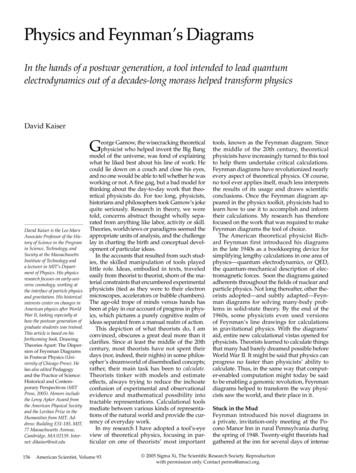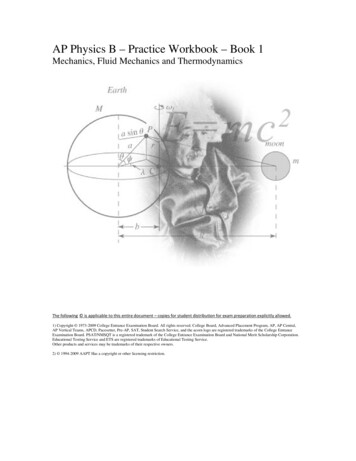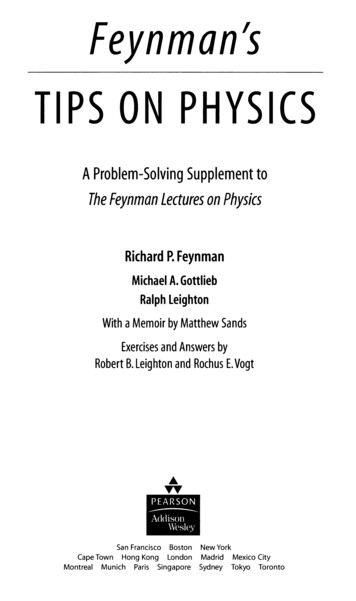
Transcription
'e nman sA Problem-Solving Supplement toThe Feynman Lectures on PhysicsRichard P. FeynmanMichael A. GottliebRalph LeightonWith a Memoir by Matthew SandsExercises and Answers byRobert B. Leighton and Rochus E. VogtPEARSONAddisonWesleySan Francisco BostonCape Town Hong Kong LondonMontreal Munich Paris SingaporeNew YorkMadrid Mexico CitySydney Tokyo Toronto
Editor-in-Chief: Adam BlackDevelopment Associate: Brad PattersonSenior Marketing Manager: Christy LawrenceManaging Editor: Erin GreggProduction Supervisor: Shannon TozierProduction Management and Composition: WestWords, Inc.Illustration: AthertoncustomsManufacturing Buyer: Michael EarlyPrinter and Binder: CourierText Designer: Lisa DevenishCover Designer: Yvo Riezebos DesignCover Credit: Feynman circa 1962, (photographer unknown) courtesy of RalphLeightonLibrary of Congress Cataloging-in-Publication DataFeynman, Richard Phillips.Feynman's tips on physics : a problem-solving supplement to the Feynman lec tures on physics I Richard P. Feynman, Michael A. Gottlieb, and Ralph Leighton;with a memoir by Matthew Sands; exercises and answers by Robert B. Leightonand Rochus E. Vogt.p. em.Includes index.ISBN 0-8053-9063-4 (pbk.)1. Physics. 2. Physics-Problems, exercises, etc. I. Gottlieb, Michael A.II. Leighton, Ralph. III. Sands, Matthew L. (Matthew Linzee).IV. Leighton, Robert B. V. Vogt, Rochus E. V I. Feynman, Richard Phillips.Feynman lectures on physics. V II. Title.QC23.F47 1989 Suppl.530'.076-dc222005013077ISBN 0-8053-9063-4Copyright 2006 Michelle Feynman, Carl Feynman, Michael Gottlieb, andRalph Leighton. All rights reserved. Manufactured in the United States ofAmerica. This publication is protected by Copyright and permission shouldbe obtained from the publisher prior to any prohibited reproduction, storagein a retrieval system, or transmission in any form or by any means, electronic,mechanical, photocopying, recording, or likewise. To obtain permission(s)to use material from this work, please submit a written request to PearsonEducation, Inc., Permissions Department, 1900 E. Lake Ave., Glenview,IL 60025. For information regarding permissions, call (847) 486-2635.Many of the designations used by manufacturers and sellers to distinguish theirproducts are claimed as trademarks. W here those designations appear in this book,and the publisher was aware of a trademark claim, the designations have beenprinted in initial caps or all caps.10 9 8 7 6 5 4 3 2 1 - CRW- 08 07 06 05www.aw-bc.com
ForewordAt a lonely border post high on the Himalayan frontier, RamaswamyBalasubramanian peered through his binoculars at the People's LiberationArmy soldiers stationed in Tibet-who were peering through their scopesback at him. Tensions between India and China had been high for severalyears since 1962, when the two countries traded shots across their disputedborder. The PLA soldiers, knowing they were being watched, tauntedBalasubramanian and his fellow Indian soldiers by shaking, defiantly, highin the air, their pocket-sized, bright-red copies of Quotations fromChairman Mao-better known in the West as "Mao's Little Red Book."Balasubramanian, then a conscript studying physics in his spare time,soon grew tired of these taunts. So one day, he came to his observation postprepared with a suitable rejoinder. As soon as the PLA soldiers started wav ing Mao's Little Red Book in the air again, he and two fellow Indian sol diers picked up and held aloft the three big, bright-red volumes of TheFeynman Lectures on Physics.One day I received a letter from Mr. Balasubramanian. His was amonghundreds of letters I have received over the years that describe the lastingimpact Richard Feynman has had on people's lives. After recounting the"red-books" incident on the Sino-Indian frontier, he wrote: "Now, twentyyears later, whose red books are still being read?"Indeed. Today, more than forty years after they were delivered, TheFeynman Lectures on Physics are still being read-and still inspire--evenin Tibet, I suspect.A special case in point: several years ago I met Michael Gottlieb at aparty where the host was displaying on a computer screen the harmonicovertones of a live Tuvan throat-singer-the kind of event that makes liv ing near San Francisco such fun. Gottlieb had studied math and was veryinterested in physics, so I suggested he read The Feynman Lectures onPhysics-and about a year later, he devoted six months of his life to read ing The Lectures very carefully from beginning to end. As Gottliebdescribes in his introdution, this led, eventually, to the book you are read ing now, as well as to a new, "Definitive Edition" of The Feynman Lectureson Physics.Ill
iv F 0 R EW0 R DThus I am pleased that people interested in physics all over the world cannow study, with the addition of this supplemental volume, a more correctand complete edition of The Feynman Lectures on Physics-a monumentalwork that will continue to inform and inspire students for decades to come,whether in midtown Manhattan or high in the Himalayas.Ralph LeightonMay 11, 2005
IntroductionRichard Feynma n, circa 1962Ifirst heard of Richard Feynman and Ralph Leighton in 1 986, through theirImet Ralph at a party. We became friends, and over the next year we workedentertaining bookSurely You 're Joking, Mr. Feynman! Thirteenyears latertogether on the design of a fantasy stamp honoring Feynman. 1 All the whileRalph was giving me books to read, by or about Feynman, including (sinceIam a computer programmer)Feynman Lectures on Computation. 2Thediscussion of quantum mechanical computation in this fascinating bookintrigued me, but without having studied quantum mechanics, I had diffi culty following the arguments. Ralph recommended I read The FeynmanLectures on Physics Volume Ill: Quantum Mechanics, which I began, butChapters I and 2 of Volume Ill are reproduced from Chapters 37 and 38 ofVolume I, so I found myself backtracking through references in Volume Irather than progressing through Volume Ill. I therefore decided to read allThe Feynman Lectures from beginning to end-I was determined to learnsome quantum mechanics ! However, that goal became secondary as time10ur stamp appears in the liner notes of Back TUVA Future, a CD featuring the Tuvanthroat-singing master Ondar and a cameo appearance by Richard Feynman (WarnerB ros. 9 47131-2), released in 1999.2Feynman Lectures on Computation, by Richard P. Feynman, edited by Anthony J.G.Hey and Robin W. Allen. 1996. Addison-Wesley, ISBN 0-20 1-48991-0.v
viI NTR0 D U CTI 0 Nwent on and I became increasingly absorbed in Feynman 's fascinatingworld. The j oy of learning physics, simply for the pleasure of it, became myhighest priority. I was hooked ! About halfway throughVolume I,I took abreak from programming and spent six months in rural Costa Rica study ingThe Lectures full-time.Every afternoon I studied a new lecture and worked on physics prob lems ; in the mornings I reviewed and proofread yesterday 's lecture. I wasin e-mail contact with Ralph, and he encouraged me to keep track of errorsI mentioned encountering inVolume I. It was not much of a burden, becausethere were very few errors in that volume. However, as I progressedthroughVolumes II and Ill,I was dismayed to discover increasingly moreerrors. In the end I had compiled a total of more than 1 70 errors inLectures.TheRalph and I were surprised: how could so many errors have beenoverlooked for so long? We decided to see what could be done about get ting them corrected in the next edition .Then I noticed some intriguing sentences in Feynman 's preface :"The reason there are no lectures on how to solve problems is becausethere were recitation sections. Although I did put in three lectures in thefirst year on how to solve problems, they are not included here. Also therewas a lecture on inertial guidance which certainly belongs after the lectureon rotating systems, but which was, unfortunately, omitted."This suggested the idea of reconstructing the missing lectures and, ifthey proved interesting, offering them to Cal tech and Addison-Wesley forinclusion in a more complete and error-corrected edition ofThe Lectures.B ut first I had to find the missing lectures, and I was still in Costa Rica !Through a bit of deductive logic and investigation, Ralph was able to locatethe lecture notes, which were previously hidden away somewhere betweenhis father 's office and the Caltech Archives. Ralph also obtained taperecordings of the missing lectures, and while researching errata in theArchives after my return to California, I fortuitously discovered the black board photos (long believed lost) in a box of miscellaneous negatives. TheFeynman heirs generously gave us permission to use these materials, andso, with some useful critiques from Matt Sands, now the only survivingmember of the Feynman-Leighton-Sands trio, Ralph and I reconstructedReview B asa sample, and presented it with the errata forThe Lectures toCaltech and Addison-Wesley.Addison-Wesley received our ideas enthusiastically, but Caltech wasinitially skeptical. Ralph therefore appealed to Kip Thome, the RichardFeynman Professor of Theoretical Physics at Cal tech, who eventually man aged to achieve a mutual understanding among all involved, and who gen erously volunteered his time to oversee our work. Since Caltech did not want
I NTR 0 D U CTI 0 N viito amend the existing volumes of The Lectures for historical reasons, Ralphproposed putting the missing lectures in a separate book. That is the originof this supplementary volume. It is being published in parallel with a newDefinitive Edition of The Feynman Lectures on Physics, in which the errorsI found are corrected, as are other errors found by a number of other readers .Matt Sands' memoirIn our quest to reconstruct the four lectures, Ralph and I had many ques tions. We felt very fortunate to be able to get answers from Professor MattSands, the man whose idea it was to embark on the ambitious proj ect thatproducedThe Feynman Lectures on Physics.We were surprised that thestory of their genesis was not widely known, and realizing that this proj ectoffered an opportunity to remedy that deficit, Professor Sands kindlyagreed to write a memoir on the origins of The Feynman Lectures for inclu sion in this supplement.The fou r lectu resFrom Matt Sands we learned that in December 1 96 1 , toward the end of thefirst term3 of Feynman's Caltech freshman physics course, it was decidedthat it would be unfair to introduce new material to the students just a fewdays before the final exam. So, for the week preceding the test, Feynmangave three optional review lectures, in which no new material was intro duced. The review lectures were intended for students having diffi culties inthe class, and emphasized techniques for understanding and solving physicsproblems. Some of the example problems were of historical interest,including the discovery of the atomic nucleus by Rutherford, and the deter mination of the mass of the pi meson. With characteristic human insight,Feynman also discussed the solution to another kind of problem, equallyimportant to at least half the students in his freshman class: the emotionalproblem of finding oneself below average.The fourth lecture, Dynamical Effectsand Their Applications,was givenearly in the second term of the freshman class, shortly after the studentsreturned from winter break. Originally, it was to beLecture21,and theidea behind it was to take a rest from the difficult theoretical discussion of3 The academic year at Caltech is divided into three terms; the first runs from lateSeptember to early December, the second from early January to early March, and thethird from late March to early June.
viii I NTR0 D U CTI 0 Nrotations presented in Chapters 1 8 through 20 and show the students someinteresting applications and phenomena that arise from rotations, "just forentertainment." Most of the lecture was devoted to a discussion of technol ogy that was relatively new in 1 962: practical inertial guidance. Theremainder of the lecture discussed natural phenomena that arise from rota tions, and also offered a clue as to why Feynman described the omission ofthis lecture from The Feynman Lectures on Physics as "unfortunate."After the lectu reAfter ending a lecture Feynman often left his microphone on. This has pro vided us with the unique opportunity of witnessing how Feynman inter acted with his undergraduate students. The example given here, recordedafter Dynamical Effects and Their Applications, is particularly noteworthyfor its discussion of the incipient transition in real-time computing fromanalog to digital methods in 1 962.The exercisesIn the course of this project Ralph reestablished contact with his father'sgood friend and colleague Rochus Vogt, who graciously gave his permis sion to republish exercises and solutions from Exercises in IntroductoryPhysics, the collection that Robert Leighton and he had created especiallyfor The Lectures back in the 1 960s. Due to space limitations I chose onlyexercises for Volume/, Chapters 1 through 20 (the material covered beforeDynamical Effects and Their Applications), preferring problems that, toquote Robert Leighton, "are numerically or analytically simple, yet incisiveand illuminating in content."WebsiteReaders are invited to visit www.feynmanlectures.info for more informa tion on this volume and The Feynman Lectures on Physics.Mike GottliebPlaya Tamarindo, Costa Ricamg@ feynmanlectures.info
AcknowledgmentsWe wish to express our heartfelt thanks to all who made this book possible,especially:Chairman of the Physics, Mathematics, andAstronomy Division, for approving this project on behalf of Caltech, andCarl Feynman and Michelle Feynman, heirs to Richard Feynman, fortheir permission to publish their father's lectures in this book;Thomas Tombrello,Matthew Sands,for his wisdom, knowledge, constructive comments, andsuggestions;Michael Hartl, for his meticulous proofreading of the manuscript, and forhis diligent work with the errata in The Feynman Lectures on Physics;Rochus E. Vogt, for the ingenious problems and answers in Exercises inIntroductory Physics, and for his permission to use them in this volume;for studiously documenting Feynman's lectures at the HughesAircraft Corporation, and for sharing those notes with us;John Neer,Helen Tuck,Feynman's secretary for many years, for her encouragementand support,Editor-in-Chief for Physical Sciences at Addison-Wesley, forhis enthusiasm and perseverance in bringing this volume to print, andAdam Black,for his grace and tireless work securing the trust and supportof everyone involved, and for overseeing our work.Kip Thorne,ix
ContentsvIntroductionOn the Origins of The FeynmanLectures on PhysicsA MEMOIR BY MATTHEW SANDS11PrerequisitesREVIEW lECTURE A21-1Introduction to the review lecture1-2Caltech from the bottom1-3Mathematics for -7Differentiating vectors1516181922231-8Line integrals1-9A simple example1-10 Triangulation29313338Laws and IntuitionREVIEW lECTURE B---- -- -- -------2-1The physical laws2-2The nonrelat ivistic approximation412-3Motion w ith forces43442-4Forces and their potentials2-5Learning physics by example472-6Understanding physics physically2-7A problem in machine design2-8Earth's escape velocity49505364xi
xii C0 NTE NT5Alternate SolutionsFinding the acceleration of the weight using geometryBFinding the acceleration of the weight usingC367Atrigonometry6768Finding the force on the weight using torque andangular momentum69Problems and SolutionsREVIEW lECTURE C43-1Satellite motion3-2Discovery of the atomic nucleus3-3The fundamental rocket equation713-4A numerical integration3-5Chemical rockets768082843-6lon propulsion rockets3-7Photon propulsion rockets3-8An electrostatic proton beam deflector883-9Determining the mass of the pi meson918588Dynamical Effects and Their ApplicationsREVIEW lECTURED4-1A demonstration gyroscope4-2The directional gyro97984-3The artificial horizon4-4A ship-stabilizing gyroscope96994-5The gyrocompass4-6Improvements in gyroscopes design and construction4-7Accelerometers4-8A complete navigational system4-9Effects of the earth's rotation4-10 The spinning disk4-11 Earth's nutation1 001111151191221254-12 Angular momentum in astronomy1254-13 Angular momentum in quantum mechanics4-14 After the lecture128127104
C0 NTE NTS5 Selected Exercises5-1Conservation of energy, statics5-2Kepler's laws and gravitation5-3Kinematics1351381385-4Newton's laws5-5Conservation of momentum1395-6Vectors5-7Nonrelativistic two-body collisions in 3 dimensions1411435-8Forces5-9Potentials and fields1445-10 Units and dimensions1451475-11 Relativistic energy and momentum1475-12 Rotations in two dimensions, the center mass5-13 Angular momentum, the moment of inertia5-14 Rotation in three dimensionsAnswers to ExercisesPhoto Credits1557 59/ndex toThelectures767151148149144xiii
On the Origins ofThe Feynman Lectures on PhysicsA MEMOIR BY MATTHEW SANDSEducation reform in the 1 950sWhen I first became a regular faculty member at Caltech in 1 95 3 , I wasasked to teach some graduate courses. I found myself quite dismayed aboutthe course program for the graduate students . During the first year theywere given courses only in classical physics-mechanics and electricityand magnetism. (And even the E and M class covered only statics, no radi ation theory at all . ) I thought it was disgraceful that these hotshot studentswere not exposed to the ideas of modem physics (many of which hadalready been around for 20 to 50 or more years) until their second or thirdyear in grad school. So I began a campaign to reform the program. I hadknown Richard Feynman since our days at Los Alamos, and we had bothcome to Cal tech a few years back. I asked Feynman to j oin the campaign,and we outlined a new program and eventually persuaded the physicsfaculty to adopt it. The first year program consisted of a course inElectrodynamics and Electron Theory (taught by me) , IntroductoryQuantum Mechanics (taught by Feynman), and, as I recall, a course inMathematical Methods, taught by Robert Walker. I think that the new pro gram was quite successful.At about that time Jerrold Zacharias of MIT was stimulated by theappearance ofSputnik topush for a program to revitalize the teaching ofhigh school physics in the United States. One result was the creation of thePSSC (Physical Science Study Committee) program, and the generation ofmany new materials and ideas, as well as some controversy.When the PSSC program was nearing its completion, Zacharias andsome colleagues (I believe among them Francis Friedman and PhilipMorrison) decided that it was time to tackle also a revision of universityphysics. They organized a couple of large meetings of physics instructors,out of which came the formation of the Commission on College Physics, anational committee of a dozen university physics instructors, which was
2 AM E M O I RBYM AT T H E WS A N D Ssupported by the National Science Foundation, and was charged with stim ulating some national endeavors for the modernization of physics teachingin colleges and universities . Zacharias invited me to those first meetingsand I later served on the Commission, eventually becoming its chairman.The Caltech prog ramThese activities prompted me to begin thinking about what could be donewith the Cal tech undergraduate program, with which I had long been ratherunhappy. The introductory course in physics was based on the book ofMillikan, Roller, and Watson, a very fine book that had been written, Ibelieve, in the 1 930s, and, though revised later by Roller, had little or nomodern physics. Further, the course was taught without lectures, so therewas little opportunity to introduce new material . The strength of the coursewas a set of intricate "problems" compiled by Foster Strong' , which wereused for weekly homework assignments, and two weekly recitation sec tions in which the students discussed the assigned problems .Like other physics faculty, I was each year assigned to be the advisor toa handful of physics maj ors. When talking with the students, I was oftendismayed that by their j unior year these students were getting discouragedabout continuing in physics-it seemed at least in part because they hadbeen studying physics for two years, but still had not been exposed to anyof the ideas of current physics. So it was that I decided not to wait for thenational program to mature, but to try to do something at Caltech. In par ticular, I wanted to see some of the content of "modern" physics-atoms,nuclei, quanta, and relativity-brought into the introductory course. Afterdiscussions with a few colleagues-most notably Thomas Lauritsen andFeynman-1 proposed to Robert B acher, then head of physics, that weshould start a program to reform the introductory course. His initialresponse was not very encouraging. He said, in effect: "I have been tellingpeople we have a very fine program that I am proud of. Our discussion sec tions are staffed by some of our senior faculty. Why should we change?" Ipersisted and was supported by a few others, so Bacher relented, acceptedthe idea, and had soon secured a grant from the Ford Foundation (for, if Iremember correctly, something more than a million dollars). The grant wasto be used for the costs of devising new equipment for the introductory1 The exercises in Chapter 5 of this volume include more than a dozen problems fromFoster Strong's collection that were reproduced with permission in Exercises inIntroductory Physics by Robert B. Leighton and Rochus E. Vogt.
AM E M O I RBYM AT T H E WS A N D S 3labs, and for developing new content for the course-in particular, for sometemporary faculty to pick up the regular duties of the ones who were devot ing time to the proj ect.When the grant was received, B acher appointed a small task force tolead the program: Robert Leighton, as chairman, Victor Neher, and me.Leighton had long been involved in the upper division program-of whichhis bookPrinciples of Modern Physics 2 was the mainstay-and Neher wasknown as a brilliant instrumentalist. I was, at the time, miffed that B acherhad not asked me to be the leader of the group. I guessed that it may havebeen partly because I was already fairly busy running the SynchrotronLaboratory, but I have always thought that he was also worried that I mightbe too "radical" and that he wanted to balance the proj ect with Leighton'sconservatism.The committee agreed from the start that Neher would concentrate ondeveloping new labs-about which he had many ideas-and that we shouldwork toward presenting a lecture course in the following year-feeling thatthe lectures would provide the best mechanism for developing a new coursecontent. Leighton and I were to design a syllabus for the lectures. We beganby working independently to produce course outlines, but meeting weeklyto compare progress and to try to reach a common ground.Impasse and inspirationIt soon became clear that a common ground was not easily to be found. Iusually saw Leighton's approach to be too much of a rehash of the contentof physics courses that had been in vogue for 60 years . Leighton thoughtthat I was pushing impractical ideas-that freshmen were not ready for the"modern" content I wanted to introduce. I was, fortunately, bolstered in myresolve by frequent conversations with Feynman. Feynman was alreadywell known as an impressive lecturer, and was particularly adept at explain ing the ideas of modern physics to a general audience. I would frequentlystop at his house on the way home from the Institute to sound him out onwhat I was thinking, and he would often make suggestions about whatmight be done, and was generally supportive.After several months of these efforts, I became rather discouraged ; Ididn ' t see how Leighton and I could ever come to an agreement on a syl labus. Our concepts for the course seemed to be completely at odds . Then2Principles of Modern Physics, by Robert B. Leighton, 1 959, McGraw-Hill, Libraryof Congress Catalog Card Number 58-8847.
4 AM E M O I RBYM AT T H E WS A N D Sone day I had an inspiration: Why not ask Feynman to give the lectures forthe course? We could provide him with the outlines of both Leighton andmyself, and let him decide what to do. I immediately proposed this idea toFeynman in the following way : "Look, Dick, you have now spent fortyyears of your life seeking an understanding of the physical world. Here isan opportunity for you to put it all together and present it to a new genera tion of scientists. Why don ' t you give the freshman lectures next year?" Hewas not immediately enthusiastic, but we continued over the next fewweeks to discuss the idea, and he was soon caught up in the notion. Hewould say maybe we could do this or that. Or this would fit in here, and soon. After a few weeks of such discussions, he asked me: "Has there everbeen a great physicist who has presented a course to freshmen?" I told himthat I didn ' t think that there ever had been. His response: "I ' ll do it."Feynman wil l give the lectu resAt the next meeting of our committee I presented with great enthusiasm myproposal-only to be dismayed by the cool response of Leighton. "That'snot a good idea. Feynman has never taught an undergraduate course. Hewouldn ' t know how to speak to freshmen, or what they could learn ." ButNeher saved the day. His eyes lit up with excitement and he said: "Thatwould be great. Dick knows so much physics, and knows how to make itinteresting . It would be fantastic if he would really do it." Leighton waspersuaded, and once persuaded, supported the idea wholeheartedly.Some days later I faced the next hurdle. I presented the idea to Bacher.He didn ' t think much of it. He considered that Feynman was too importantto the graduate program and could not be spared. Who would teach quan tum electrodynamics? Who would be working with the theoretical gradu ate students ? And besides, could he really bend down to the level of thefreshmen? At this point I did some lobbying with some of the senior mem bers of the physics department, who put in some supporting words toBacher. And finally, I used the argument dear to academics: If Feynmanreally wants to do it, do you want to say that he should not? The decisionwas made.With six months remaining before the first lecture, Leighton and I talkedwith Feynman about what we had been thinking. He started to work inten sively on developing his own ideas . At least once each week I would stopby his house, and we would discuss what he had been thinking. He wouldsometimes ask whether I thought that some particular approach would beaccessible to the students , or whether I would think that thi s or that
AM E M O I RBYM AT T H E WS A N D S 5sequence of material would "work" best. I may mention a particular exam ple. Feynman had been working on how to present the ideas of wave inter ference and diffraction, and was having difficulty finding a suitablemathematical approach-one both straightforward as well as powerful. Hewas not able to come up with one without the use of complex numbers. Heasked me whether I thought the freshmen would be able to work with thealgebra of complex numbers . I reminded him that the students admitted toCaltech had been selected primarily on their demonstrated abilities withmathematics, and that I was confident that they would not have problemsdealing with complex algebra, so long as they were given some brief intro duction to the subj ect. His twenty-second lecture contains a delightfulintroduction to the algebra of complex quantities, which he was then ableto use in many of the following lectures for the description of oscillatingsystems, for problems in physical optics, and so on.Early on, a small problem surfaced. Feynman had a long-time commit ment to be absent from Caltech for the third week of the fall term, and sowould miss two class lectures. We agreed that that problem was easilysolved. I would substitute for him on those days. However, in order not tobreak the continuity of his presentation, I would give the two lectures onsome subsidiary topics that might be useful to the students, but were notrelated to his main line of development. This explains why Chapters 5 and6 ofVolume I are somewhat anomalous.For the most part, however, Feynman worked alone at developing acomplete outline of what he would do for the whole year-filling in enoughdetail to be sure that there would not be unforeseen difficulties. He workedintensely for the rest of that academic year, and by September (now 1 96 1 )was ready to begin his first year of lectures.The new physics cou rseOriginally it was considered that the lectures given by Feynman wouldform the starting point of an evolution of a revised program for the two year introductory course-one required of all of the incoming students atCal tech. It was thought that in succeeding years others of the faculty wouldtake over responsibility for each of the two years, developing eventually a"course"-with a textbook, homework exercises, a laboratory, and so on.For the first years of the lectures, however, a different format needed tobe devised. No course materials were available and had to be created as wewent along. Two one-hour lectures were scheduled-at 1 1 a.m. on Tuesdayand Thursday, and students were assigned to a one-hour discussion section
6 AM E M O I RBYM AT T H E WS A N D Seach week, which was led by a faculty member or a graduate student assis tant. There was also a three-hour laboratory each week, under the directionof Neher.During the lectures Feynman carried a microphone, suspended from hisneck and coupled to a magnetic tape recorder in another room. Photographswere periodically taken of the contents of the blackboards. Both serviceswere managed by Tom Harvey, the technical assi stant in charge of the lec ture hall. Harvey also helped Feynman devi
Feynman's tips on physics : a problem-solving supplement to the Feynman lec tures on physics I Richard P. Feynman, Michael A. Gottlieb, and Ralph Leighton ; with a memoir by Matthew Sands; exercises and answers by Robert B. Leighton and Rochus E. Vogt. p. em. Includes index.
